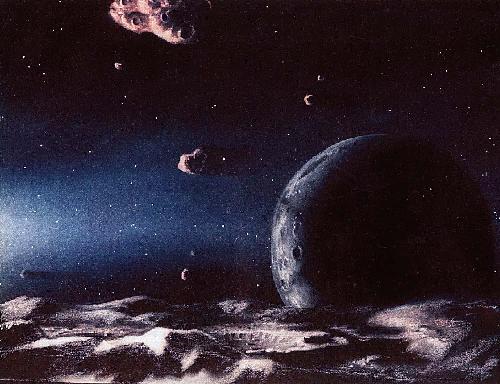|
Crystalline Ice on Kuiper Belt Object (50000) Quaoar
David
Jewitt (University of Hawaii) and Jane Luu (Lincoln Laboratory, MIT)
Nature, 2004, 432, 731 (December 9 issue).
|
In a Nutshell
The
Kuiper belt is the repository of the Solar System's most primitive
ices and organic molecules and is widely thought to be the source of the
short-period (specifically "Jupiter Family") comets. For these reasons,
there is great interest in determining the compositions of the Kuiper Belt
Objects (KBOs) but, owing to the faintness of objects beyond Neptune,
this has proved fantastically challenging even with the world's largest
telescopes.
In the Nature paper, we present the first high quality spectrum of bright
KBO (50000)
Quaoar taken with the CISCO spectrometer at the
Subaru 8-m
telescope on Mauna Kea.

Caption: Reflection spectrum of Quaoar at near-infrared wavelengths.
The black line shows Subaru/CISCO data. The red line is a spectrum of water ice
overplotted for comparison.
Broad minima at 1.5 and 2.0 microns indicate water ice on the surface.
A sharper minimum at 1.65 micron proves that the ice is crystalline
in structure, rather than amorphous. Thick, black horizontal bars indicate
wavelengths at which the Earth's atmosphere strongly absorbs. Data at these
wavelengths are more noisy and less trustworthy. (Click on the figure to enlarge it.)
What Does This Mean?
The
crystallinity of the ice indicates something about the temperature
history of the ice.
The surface temperature of Quaoar is only 50 K
(-220 C) and, at these low temperatures, the thermodynamically
preferred form of ice is amorphous (meaning "structureless": the water
molecules freeze where they stick in a jumbled pattern). Our Subaru spectrum
shows instead that the ice is crystalline (from the 1.65 micron absorption
band, which is weak or absent in amorphous ice). Crystalline ice, in which the water molecules are arranged in a regular
lattice-like pattern, indicates formation at temperatures in excess of
110 K (about -160 C). Our data
show that the ice on Quaoar has at some time been raised in
temperature above 110 K, the critical temperature for transformation
from amorphous to crystalline.
Two ways to heat the ice are 1) to
form it at temperatures above 110 K, presumably beneath the frigid
surface, and then somehow expose it to view from Earth. Warm ice could
be excavated by impact from deeper layers, or blown onto the surface by
low-level cryovolcanic outgassing through vents. 2) Ice on the surface
could be heated above 110 K by micrometeorite impact.
And So?
The extra wrinkle is that crystalline ice, however it came to be
emplaced on the surface of Quaoar, is itself unstable. Bombardment by
energetic particles from the solar wind and by cosmic rays breaks the
bonds between molecules in the crystalline lattice producing amorphous
ice. The timescale for this "back-conversion" of crystalline to
amorphous ice is uncertain but probably on the order of 10 Myr for the
surface ice. 10 Myr is effectively "yesterday" compared to the 4500
Myr age of the solar system. This means that whatever process emplaces
the crystalline ice (basically either impact gardening or cryovolcanic
outgassing) has been active in the immediate past and, indeed, is
probably still active.
A two-step scenario seems plausible. First, buried ice is heated by
radiogenic decay in the interior of Quaoar. Ammonia in the ices
depresses the melting temperature and crystalline water exudes onto the
surface, much as we have seen in Voyager images of the icy (and
crystalline) satellites of Uranus (e.g. 480 km diameter
Miranda). This probably happened billions of
years ago when radioactivity was a little stronger than it is now.
Second, some resurfacing process (impact gardening or burps of gas with
entrained ice crystals percolating to the surface) replenishes the
optical surface on a much shorter (<10 Myr) timescale, erasing
the destructive effects of energetic particle bombardment.
While the interpretation remains speculative, the good news is that
we are, for the first time, able to take useful spectra that reveal unexpected
and intriguing properties of the surface of distant Quaoar.
The
Nature paper is
linked here as a pdf file.
An associated
"News and Views" riff on this paper by Dave Stevenson.
Some notes about how to pronounce Quaoar are
here.


